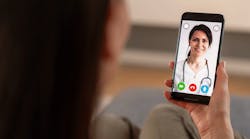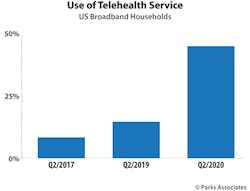Latest from Network Transformation/Edge Compute/IoT/URLLC/Automation/M2M
Edge Compute = Tele-Healthy
COVID-19 caused a massive increase in telehealth and health tech adoption among both consumers and care professionals.
In some cases, the industry was judged to have undergone 5 to 10 years of changes within the span of just several months.
Connectivity is necessary in order to gather data from devices both in patients’ homes and in healthcare settings. However, it is not enough to simply receive the data — the value of data lies in its interpretation and use. Thankfully, network evolutions in computing and connectivity are driving new developments in the health IoT space. The key is to unlock the value of health device data via the use of edge computing, machine learning, and health flexible IoT platforms.
Health Technology on the Rise
• A Parks Associates consumer survey captured a nearly threefold increase in remote visits with a healthcare practitioner. These consumers reported positive experiences and high levels of satisfaction. Interestingly, consumers ages 65 and older had higher satisfaction than younger people.
• What’s more, many connected health device owners are particularly interested in sharing data from their connected health devices with telehealth services. Currently, 64% of connected health device owners report that services that allow them to share device data are "appealing" (rating 5-7 on a 7-point scale), vs. 43% of non-owners.
• Consumers also report high intentions to purchase connected health products. As of May 2020, 29% of heads of US broadband households were very likely to purchase at least 1 type of connected health product in the next 12 months, with 25% interested in medical devices and 17% interested in wearables.
InvisiLight® Solution for Deploying Fiber
April 2, 2022Go to Market Faster. Speed up Network Deployment
April 2, 2022Episode 10: Fiber Optic Closure Specs Explained…
April 1, 2022Food for Thought from Our 2022 ICT Visionaries
April 1, 2022On the care professional side; telehealth vendors, telehealth specialists, and care providers saw huge utilization boosts during the beginning of the COVID-19 crisis. Two examples below illustrate this compelling trend:
• Amwell, a leading telehealth platform, reported a 1,000% increase in virtual visits due to COVID-19, with even higher increases in certain locations.
• Northwell Health, a NYC-based hospital system, reported a 900% increase in its ambulatory telehealth visits within just the first six weeks of the COVID-19 crisis in New York.
A Flawed Model — and an Emerging Solution
Although many virtual platforms offer greater operational efficiencies than in-person visits and in certain circumstances result in improved patient outcomes, many virtual care solutions also have substantive weaknesses that make them unsuitable as a core means of seeking or providing care. Some solutions are remote visit only and lack the means to gather important vital sign and clinical testing data. This significantly limits the use cases of telehealth — limiting the ability to use virtual solutions for tracking chronic conditions, for monitoring those patients who are at an elevated risk of complications due to a disease state, those who are pre- or post-surgery, and others who may benefit from tracking data.
The solution to this problem is to layer in remote patient monitoring platforms in order to collect vital sign and biometric data from connected health devices. However, while these platforms exist and are highly in demand by care professionals, many existing programs have not yet been scaled to the same extent as remote visit solutions. A number additionally suffer from user experience flaws, causing user error and frustration with regards to pairing devices and taking accurate measurements.
High levels of consumer demand for connected health devices point to a growing interest in health data and actionable insights among consumers as well. Consumers want to be able to access this data and share it with their care providers. This stands to substantially boost the remote patient monitoring model.
Edge Computing: A Healthy Option
The COVID-19 pandemic has accelerated change and evolution in the healthcare industry. It has taught us that there is a need for health IoT for both in-patient and outpatient settings, and also among consumers. Next-gen approaches to health IoT should collect health data, integrate with robust platforms and services, and provide intelligent feedback and interpretation in order to support clinical decision-making.
New approaches to edge computing — called the "agile edge" — make the most of software-defined computing models, offering increased performance and reliability as compared to traditional on-premise or even cloud computing, incorporating flexible device firmware capable of being updated with new functionality and security enhancements, and allowing connected health devices to holistically work together in various scalable solutions. This promises to unlock the value of health data, as well as substantially boost care outcomes and lower care provider fatigue.
Three examples illustrate the use cases for edge computing, machine learning, and Artificial Intelligence (AI) in health IoT.
1. Smart Alarm/Dashboards for Monitoring
Edge computing is capable of combining and interpreting data from multiple devices locally, leading to greater speed and intelligence. One use-case example is that of smart alarms for in-patient monitoring. Using edge computing, a smarter alarm system can be created, combining data from different monitors (e.g., verifying patient heart rate across both monitors before sounding an alarm). This allows the system to avoid the false alarms that fatigue healthcare workers.
2. Comparing Trajectory of COVID-19 Patient to Others in At-Home Setting
AI can be used to help monitor COVID-19 patients in the comfort and safety of their own homes. Devices in the home send data to remote monitoring platforms, allowing physicians to track the health of their patients. AI, paired with a rich dataset, allows physicians to identify patient trajectories and to compare a patient’s trends to others with similar trajectories. This has been used to save the lives of patients with COVID-19, identifying when patients — who may otherwise feel well enough to not realize they need help — are at risk of death and require hospitalization. This type of functionality may also be applied to the field of chronic disease monitoring as well as post-surgical recovery, among others.
3. Virtual Assistants for In-Home Care
By combining edge computing and AI, intelligent whole-home solutions may be enabled for remote patient monitoring or even eldercare. Sensor suites monitoring daily activities such as taking medication, or health metrics such as blood sugar, temperature, weight, pulse oxygen, lung capacity, and blood pressure, may be combined with smart displays featuring virtual assistants.
• The virtual assistant may encourage patients or seniors to follow through on medications, monitor their vital signs, perform rehabilitation exercises or mental health routines, or conduct video consultations with their care providers.
• The addition of depth cameras allow the solution to postural stability and gait, evaluating if seniors are at risk of falls.
Edge computing allows healthcare organizations to improve their internal operations and to better diagnose and support their patients. These solutions support various types of in-home monitoring and diagnostic devices, applications, and platforms, across a single common platform that solves many of the headaches of earlier technology.
Agile edge computing brings the power of cloud-native development home, enabled by advances in computing and connectivity, building scalable platforms that can both extend and augment provider capabilities — now and in the future.
This article was adapted from the report Next Evolution of Health IoT: Moving Towards the Edge by Parks Associates for Softeq Development Corporation, that designs and develop custom software, firmware, hardware, desktop apps, mobile apps, line-of-business web, cloud, big data, and machine learning solutions. Clients include Verizon, Epson, Microsoft, Lenovo, Intel, HP, AMD, NVIDIA, and Disney, among others. For more information, please visit http://www.softeq.com. You can also find the white paper at http://www.parksassociates.com/bento/shop/whitepapers/files/ParksAssoc-HeathIoTNextStep-WP2021.pdf.
For more information, please email [email protected] or visit http://parksassociates.com/.
Follow Kristen on Twitter @KristenAtParks
Like this Article?
Subscribe to ISE magazine and start receiving your FREE monthly copy today!










